Occupational environment monitoring at the lime factory
99,000 ₫
Note: The above price is calculated for one sample, the price may vary depending on the area of the environment to be monitored and depending on market fluctuations. For more accurate price support, please refer to the price list or contact our consulting staff directly.
Occupational environment monitoring at a lime production factory is a session of collecting, analyzing, and evaluating factors in the workplace that may harm workers health.
Table of Contents
Toggle1. Overview of Lime Production Factory
a. What is a Lime Production Factory?
Factory producing lime is a specialized industrial facility that manufactures lime, a material produced from the calcination of natural limestone or limestone slag from steel production. Limestone is extracted from limestone quarries or other natural limestone sources. The limestone is then transported to the factory for further processing.

b. Production processes in a lime production factory
The lime production process in the factory generally includes the following steps:
- Limestone extraction: Limestone is extracted from quarries or other natural sources and transported to the factory for further processing.
- Limestone processing and crushing: Limestone is processed and crushed into smaller pieces, producing clean raw material suitable for the next production steps.
- Calcination: Limestone pieces are placed in a kiln at high temperature to undergo the calcination process. During this process, the limestone melts and is then cooled to form lime.
- Processing and packaging: The produced lime is processed and packaged into different products such as lime powder, quicklime, slaked lime, and other forms. These products can be used in construction, chemical industry, agriculture, and environmental applications.

c. Machinery used in a lime production factory
In a lime production factory, various machinery and equipment are used for production processes. Common machinery includes:
- Crushers: Used to crush limestone into smaller sizes. Crushers can be jaw crushers, ball mills, vertical shaft crushers, or cone crushers.
- Kilns: Equipment used to calcine limestone at high temperatures. Kilns can be vertical kilns, rotary kilns, electric kilns, or coal-fired kilns.
- Conveying systems: Used to transport raw materials and products during production. This may include belt conveyors, pipe conveyors, screw conveyors, and other transport devices.
- Mixers: Used to mix lime components, such as crushed limestone and other additives. Mixers can be centrifugal mixers, hammer mixers, twin-shaft mixers, or screw mixers.
- Granulators: Used to form lime pellets from crushed lime. Granulators can be cone granulators, screw granulators, or roll granulators.
- Sieves: Used to separate lime particles by size. Sieves can be vibrating screens, rotary screens, cone screens, or trommel screens.

d. Occupational diseases for workers in a lime production factory
Workers in a lime production factory may be at risk of several occupational diseases due to exposure to harmful environmental factors. Common occupational diseases include:
- Stonemason’s lung: Caused by inhaling lime dust during production. Without proper protective equipment and ventilation, exposure can cause bronchitis, pneumonia, and other respiratory issues.
- Skin diseases: Exposure to lime or chemicals can cause skin irritation, eczema, or dermatitis.
- Digestive system diseases: Using lime and additives can affect the digestive system, leading to gastritis, esophagitis, or intestinal inflammation.
- Nervous system disorders: Exposure to chemicals in lime production can cause headaches, fatigue, dizziness, or other neurological problems.
- Musculoskeletal disorders: Heavy labor and prolonged physical stress can lead to back pain, joint degeneration, and other musculoskeletal injuries.
To prevent occupational diseases, workers should follow safety measures, including using personal protective equipment, adhering to safe work procedures, controlling exposure to hazardous substances, and conducting regular health check-ups.

e. Common types of lime on the market
Some common types of lime include:
- White lime (Calcium carbonate): The most common lime used in construction, chemical production, paper manufacturing, food processing, fertilizers, and other applications.
- Slaked lime (Hydrated lime): Produced by adding water to quicklime, widely used in construction, concrete production, water pH adjustment, and other applications.
- Quicklime (Quicklime): Produced by high-temperature calcination of limestone, used in construction, steel production, water treatment, and other industries.
- Dolomitic lime (Dolomite): Contains a mixture of calcium and magnesium carbonate. Used in cement production, fertilizers, pH adjustment in agriculture, and water softening.
- Limestone (Limestone): Natural lime formed from sand, burnt soil, and calcium carbonate rocks. Widely used in construction, cement production, glass manufacturing, and brick production.
2. Overview of Occupational Environment Monitoring Services
a. What is occupational environment monitoring at a lime production factory?
Occupational environment monitoring at a lime production factory involves collecting, assessing, and analyzing measurement indicators of workplace environmental factors, to implement timely measures that minimize environmental harm to workers’ health and prevent occupational diseases. This monitoring is mandatory for all lime production factories.
Occupational environment monitoring plays a crucial role in protecting and improving workers’ health, as workers are the main resource generating profit for the business. Continuous exposure to occupational hazards beyond permissible limits can affect workers’ health and lead to occupational diseases.
REGISTER FOR OCCUPATIONAL ENVIRONMENT MONITORING SERVICE
b. Occupational environment monitoring program of An Toan Nam Viet
An Toan Nam Viet’s occupational environment monitoring program is developed by engineers specializing in occupational safety and environmental protection. The program uses modern measurement methods to monitor air, water, microclimate, physical factors, dust, and other environmental conditions in the workplace. It is essential for ensuring a safe working environment and protecting workers’ health.
Additionally, the program plays a key role in researching and developing solutions to improve workplace environmental quality. With the expertise and dedication of monitoring specialists, An Toan Nam Viet’s exclusive program is a breakthrough in occupational safety and environmental protection management in Vietnam.

c. Standardization in occupational environment measurement procedures
Standardization in An Toan Nam Viet’s measurement procedures is vital to ensure accuracy and reliability. The program follows recognized standards and procedures from Ho Chi Minh City Department of Health, ensuring collected data is highly reliable for assessing and improving workplace conditions.
Standardized procedures also guarantee that measurements are conducted by experienced monitoring specialists, allowing managers and experts to trust An Toan Nam Viet’s results and make accurate decisions for workers’ health and environmental protection.
By applying standardization in measurement procedures, An Toan Nam Viet demonstrates its commitment to a safe workplace and contributes to improving occupational safety and environmental management in Vietnam.
d. Monitoring report for lime production factory
Monitoring results are prepared according to Form No. 04, Appendix III of Decree 44/2016/ND-CP and prepared in two copies: one sent to the contracting workplace and one retained by the monitoring organization.
Monitoring records are stored indefinitely in compliance with legal regulations.

e. Frequency of occupational environment monitoring according to law
According to Clause 2, Article 18 of Labor Safety and Hygiene Law 84/2015/QH13, employers must conduct occupational environment monitoring at least once a year.
f. Deadline for submitting occupational environment monitoring reports
Reports must be submitted before December 31 each year to the local Department of Health where the business has its headquarters and where workers are employed.
If there are changes in technology, production processes, or facility upgrades that may introduce new occupational hazards, businesses must update occupational safety records related to these hazards.
g. Penalties for violating occupational environment monitoring regulations for employers
According to Article 27, Decree No. 12/2022/ND-CP dated January 17, 2022:
- Clause 2: Fine from 2,000,000 – 5,000,000 VND for failing to publicly inform employees at monitoring sites about results and hazard assessments immediately after obtaining the results.
- Clause 3: Fine from 20,000,000 – 40,000,000 VND for failing to conduct occupational environment monitoring as required by law.
- Clause 4: Fine from 40,000,000 – 60,000,000 VND for collaborating with monitoring organizations to falsify monitoring results without reaching criminal liability.
3. Harmful environmental factors for workers in lime production factories
Workers in lime production factories may be exposed to the following harmful environmental factors:
- Lime dust: The lime production process often generates lime dust, consisting of fine particles that can float in the air. Long-term inhalation of lime dust can cause respiratory issues such as pneumonia, asthma, sinusitis, and digestive problems.
- Toxic gases: During lime calcination, toxic gases such as carbon monoxide (CO) and emissions from combustion equipment may be released. CO is a poisonous gas that can cause poisoning and affect the nervous, respiratory, and cardiovascular systems.
- Noise: Machinery and production processes in lime factories can generate high levels of noise. Prolonged exposure to loud noise can cause hearing problems such as hearing loss and deafness.
- Temperature and humidity: The working environment in lime factories may have high temperature and humidity due to the calcination and processing of lime. Uncomfortable temperature and humidity conditions can cause discomfort, fatigue, and dehydration.
- Chemicals: Lime production may involve chemicals such as acids, acid-containing solutions, or coloring agents. Prolonged and improper exposure to these substances can cause skin irritation, infections, and other health problems.
- Occupational accidents: Lime factories may have large machinery, high temperatures, and challenging working conditions. This increases the risk of occupational accidents such as collisions, burns, cuts, or falls.
REGISTER FOR OCCUPATIONAL ENVIRONMENT MONITORING SERVICE
4. Measures to improve the working environment in lime production factories
To improve the working environment in lime factories and protect workers’ health, the following measures can be implemented:
- Dust management: Use effective dust extraction systems and dust shielding equipment to reduce airborne lime dust. Ensure workers wear protective equipment such as masks and safety goggles.
- Adjust production processes: Modify production processes to reduce noise and pollutant emissions. Use noise reduction equipment and exhaust systems to minimize noise and toxic gases during production.
- Temperature and humidity control: Ensure comfortable and safe temperature and humidity conditions in the factory. Use air conditioning systems and ventilation fans to improve the working environment.
- Training and guidance: Provide workers with training on occupational safety, proper use of protective equipment, and safe working procedures. Regularly offer guidance and supervision to ensure compliance with safety and hygiene regulations.
- Chemical management: Ensure the safe use, storage, and handling of chemicals in compliance with environmental protection regulations. Provide appropriate protective equipment and guidance for safe chemical handling.
- Equipment inspection and maintenance: Conduct regular inspections and maintenance of machinery and equipment to ensure stable and safe operation. Train workers to use equipment safely and correctly.
- Regularly conduct occupational environment monitoring in factories, collect and analyze harmful factors affecting workers, and implement measures to reduce hazards to prevent occupational diseases.
5. Benefits of periodic monitoring in lime production factories
An Toan Nam Viet provides enterprises with significant benefits when using occupational environment monitoring services in accordance with Decree 44/2016/NĐ – CP on managing and controlling harmful factors in the working environment affecting workers.
- Enterprises can proactively control harmful factors in workshops or factories.
- Receive recommendations on measures to reduce harmful factors and improve workplace quality.
- Indirectly protect human resources, a key factor in enterprise development.
- Reduce the impact of occupational diseases on workers’ health, thereby minimizing future medical costs.
- Improved worker health enhances product quality and ensures consistent production output.
- Ensure compliance with occupational safety laws and avoid legal risks.
- Enhance credibility and professionalism in all aspects, thereby elevating the enterprise’s brand.
Nam Viet’s environmental monitoring service is a solution to minimize occupational disease risks and contribute to a healthy, high-quality working environment.

6. National occupational environment monitoring center
Occupational environment monitoring center of Nam Viet is a professional unit specializing in monitoring and measuring occupational environment quality throughout all provinces of Vietnam. With an experienced team of monitoring specialists, the center uses modern measurement equipment, ensuring accuracy and reliability.
In addition to monitoring services, the center assists clients in planning, handling, and tracking occupational environmental issues. With the motto “customers are the center,” the center prioritizes customer satisfaction, meets all client needs, and is committed to providing the best solutions for enterprises.
REGISTER FOR OCCUPATIONAL ENVIRONMENT MONITORING SERVICE
With investment in technology, equipment, and human resources, Nam Viet’s monitoring center has become one of the most reputable units in occupational environment monitoring in Ho Chi Minh City, with the following goals:
- We always value brand reputation and the quality of our services.
- We provide clients with the best and most suitable solutions possible.
- Along with a team of experienced Masters and Engineers, we aim to protect the environment and benefit enterprises.
- Working with Nam Viet Monitoring Team, companies will receive professional service from experts and enjoy the best cost advantages.
The occupational environment monitoring process at Nam Viet includes the following basic steps:
- Before monitoring, our company ensures all machinery and equipment are calibrated and adjusted according to legal regulations.
- Strictly follow the occupational environment monitoring procedures as committed to the Department of Health.
- Accurately report monitoring results to employers.
- If results indicate unsafe conditions for workers, Nam Viet will support remedial measures, and the workplace shall implement:
- Implement measures to improve working conditions to minimize harmful impacts and prevent occupational diseases.
- Organize health checks to detect occupational and work-related illnesses early for workers in unsafe environments.
- Provide allowances in kind for workers according to labor law regulations.

7. Occupational environment monitoring service quotation
To help enterprises perform occupational environment monitoring professionally and effectively, Nam Viet provides customers with a detailed quotation for occupational environment monitoring services with quality and reasonable cost.
- Our quotation provides detailed pricing information for the monitoring services we offer, including costs related to transportation, measurement, analysis, and reporting. Customers can fully rely on the accuracy and reliability of the monitoring reports we provide.
- We are committed to offering the most competitive and reasonable prices on the market and are ready to provide prompt and professional consultation for any questions regarding monitoring services.
- With Nam Viet’s monitoring quotation, customers can easily select service packages that suit their needs. We are committed to delivering the highest satisfaction with professional service quality.
No comments yet

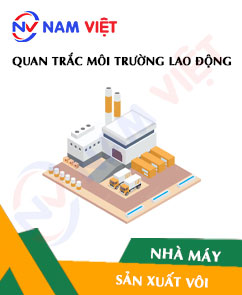
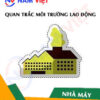
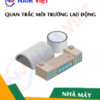



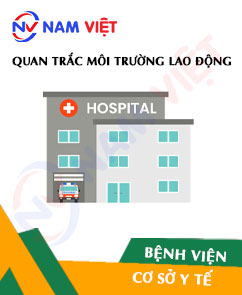

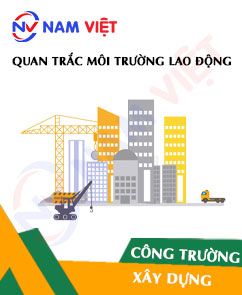
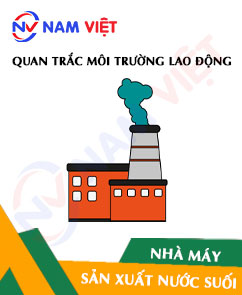
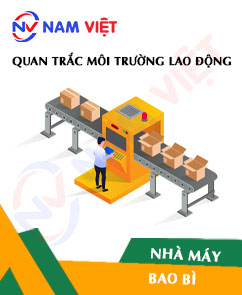
Review Occupational environment monitoring at the lime factory
There are no reviews yet.